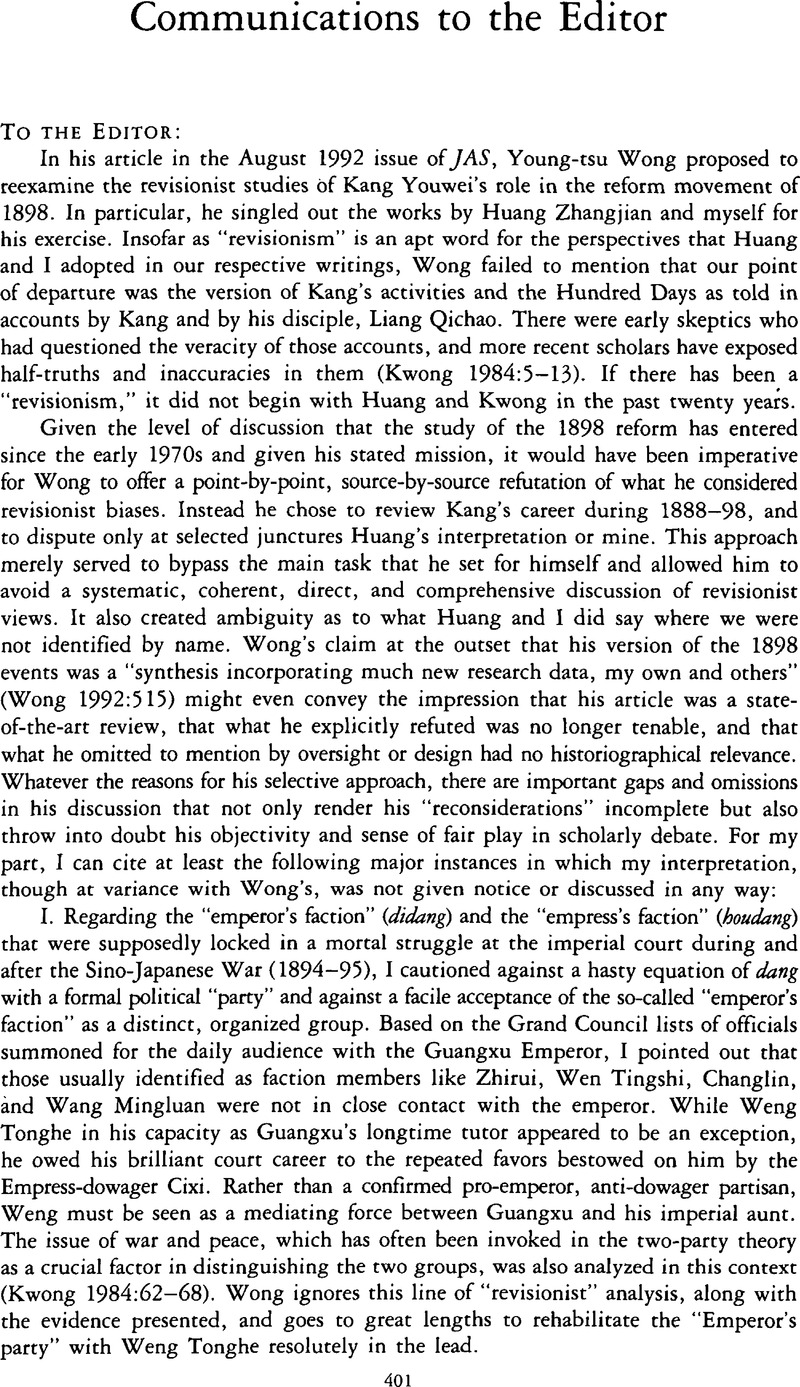No CrossRef data available.
Article contents
Communications to the Editor
Published online by Cambridge University Press: 23 March 2011
Abstract
An abstract is not available for this content so a preview has been provided. As you have access to this content, a full PDF is available via the ‘Save PDF’ action button.

- Type
- Communications to the Editor
- Information
- Copyright
- Copyright © The Association for Asian Studies, Inc. 1993
References
List of References
Guojia dang'an ju. 1958. Wuxu bianfa dang'an shiliao (Archival materials on the 1898 reform). Beijing: Guojia dang'an ju.Google Scholar
Bozan, Jian, et al. , comp. 1953. Wuxu bianfa (The 1898 reform), 4 vols. Shanghai: Shenzhou guoguang she.Google Scholar
Xiangji, Kong. 1988. Kang Youwei bianfa zouyi yanjiu (Studies on Kang Youwei's reform memorials). Shenyang: Liaoning jiaoyu chubanshe.Google Scholar
Kwong, Luke S. K. [or Kuang Zhaojiang]. 1984. A Mosaic of the Hundred Days. Cambridge, Mass.: Council on East Asian Studies, Harvard University.Google Scholar
Kwong, Luke S. K. [or Kuang Zhaojiang]. 1987. “On ‘The 1898 Reforms Revisited’: A Rejoinder.” Late Imperial China, 8. 1:214–19.CrossRefGoogle Scholar
Kwong, Luke S. K. [or Kuang Zhaojiang]. 1988. “Shangyudang wuxu shiliao juyu” (The edict files as a source on the Hundred Days Reform), in Ming Qing dang'an yu lishi yanjiu (Archives of the Ming and Qing Dynasties and historical research), ed. dang'anguan, Zhongguo diyi lishi. Beijing: Zhonghua shuju, pp. 1109–22.Google Scholar
Qichao, Liang, et al. , eds. 1967. Shiwu bao (The Chinese progress). Reprint, Taibei: Huawen shuju.Google Scholar
Qichao, Liang, et al. , eds. 1969. Wuxu zhengbian ji (An account of the 1898 reform). Taibei: Zhonghua shuju.Google Scholar
Zongyan, Wang. 1977. Du Qingshigao zaji (Reading notes on the Draft history of the Qing Dynasty). Hong Kong: Zhonghua shuju.Google Scholar
Guangming ribao [Guangming Daily], July 7, 1955, the “History” (shixue,) No. 61.Google Scholar
Hsiao, Kung-Chuan. 1957. “Weng Tonghe and the Reform Movement of 1898,” 111–243. The Tsing Hua Journal of Chinese Studies, New Series 1, No. 2 (April).Google Scholar
Hsiao, Kung-Chuan. 1975. A Modern China and a New World: Kang Youwei, Reformer and Utopian. Seattle: University of Washington Press.Google Scholar
Bozan, Jian, et al. , comp. 1953. Wuxu bianfa [The Reform of 1898], 4 vols. Shanghai: Shengzhou guoguang she.Google Scholar
Guangren, Kang. 1926. “Zhi Yiyi shu” [Letter to Yiyi], pp. la–3a. In “Kang Youbo maocai yiwen” [Works of Late Kang Guangren], in Wuxu liu junzi yiji [Collected Works of the Six Martyrs]. Shanghai: Shangwu yinshu guan.Google Scholar
Kwong, Luke. 1984. A Mosaic of the Hundred Days: Personalities, Politics, and Ideas of 1898. Cambridge, Mass.: Council of East Asian Studies, Harvard University.Google Scholar
Baoxuan, Sun. 1983. Wangshan lu rip [The Diary of Wangshan Studio], 2 vols. Shanghai: Guji chuban she.Google Scholar
Zhijun, Tang. 1981. Wuxu bianfa renwu zhuangao. [Drafted biographies of personalities related to the reform of 1898], 2 vols. Beijing: Zhonghua shuju.Google Scholar
Kangnian, Wang. 1986. Wang Kangnian shiyou shuzha [Letters of Wang Kangnian's Teachers and Friends], 4 vols. Shanghai: Guji chubanshe.Google Scholar
Tonghe, Weng. 1925. Weng Weng-gong gong riji [The Diary of Weng Tonghe]. Shanghai. Taibei: Shangwu yinshu guan reprint. 20 vols.Google Scholar
Wong, Young-Tsu. 1972. “The Significance of the Kuang-hsu Emperor to the Reform Movement of 1898,” 169–86. In Buxbaum, David and Mote, Frederick, eds., Transition and Permanence: Chinese History and Culture, A Festschrift in Honor of Dr. Hsiao Kung-chuan. Hong Kong: The Cathay Press.Google Scholar
Wong, Young-Tsu. 1992. “Revisionism Reconsidered: Kang Youwei and the Reform Movement of 1898.” The Journal of Asian Studies 51.3:513–44.CrossRefGoogle Scholar




